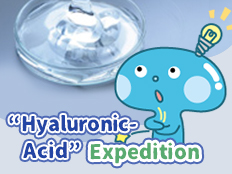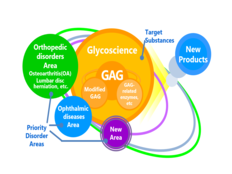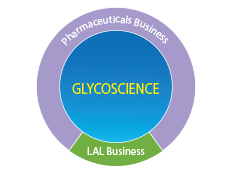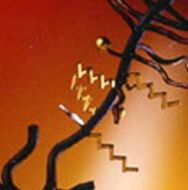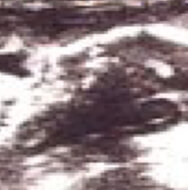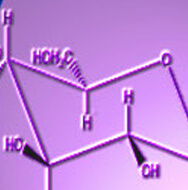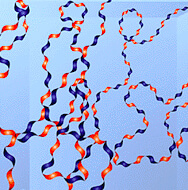The term "chondroitin sulfate" is often heard on Japanese television. It is related to cartilage, but what is the relationship between cartilage and chondroitin sulfate?
Chondroitin sulfate widely exists in bodies of animals regardless of species; in particular it exists abundantly in cartilage. It was isolated/found about 150 years ago from cartilage, and named "chondroitin" after the Greek word meaning "cartilage."
Chondroitin sulfate belongs to a group of proteoglycans, and has the structure of a sulfate bound to a sugar chain having repeats of two sugars, D-glucuronic acid and N-acetyl-D-galactosamine. Similar to the hyaluronic acid previously described, its significant characteristic is that it has a high capacity to hold moisture. Chondroitin sulfate is different from hyaluronic acid in that it exists in a state bound to a protein, that is, it exists as a structure called proteoglycan. In addition to cartilage, it also exists in many types of tissues such as bone, ligament, cornea, brain, blood vessel, and skin.
Chondroitin sulfate is known to have numerous physiological functions other than regulation of moisture. Representative examples are its function to impart elasticity to joint cartilage, and to make the movement of the joint smooth by cooperating with hyaluronic acid, etc. The joint has the structure of a "bag" called the joint capsule enveloping the ends of multiple bones, and the "bag" is filled with a "lubricating fluid" called synovial fluid. This lubricating fluid contains hyaluronic acid. The ends of bones are covered with a tissue called cartilage, and the bones are never directly in contact with each other. In other words, it is the cartilage having synovial fluid in between that is in contact when joints move, this it is because the bones are not in direct contact with each other that the joint can move smoothly. The physical base of this function is hyaluronic acid and chondroitin sulfate that are abundantly contained in the cartilage.
It has been reported that similar to hyaluronic acid, the amount of chondroitin sulfate also decreases with age. When the amount of chondroitin sulfate decreases, elasticity of cartilage is lost, for example, in the joint, and in the worst case, the cartilage abrades and the bones come in direct contact with each other. Such a condition is called osteoarthritis. Of course, decrease in chondroitin sulfate is not the only cause of joint diseases, but it can be said without doubt that chondroitin sulfate is closely associated with osteoarthritis.
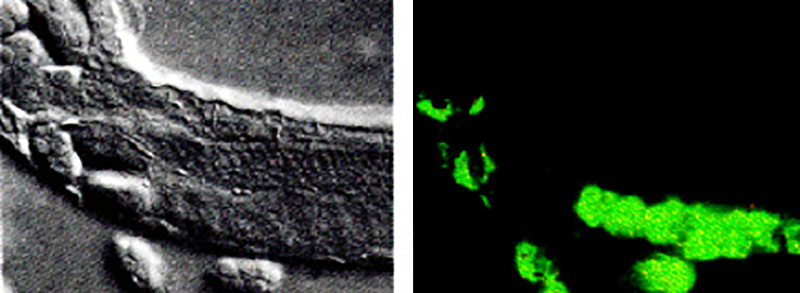
▲ Immunofluorescent Staining of Chondroitin of C. elegans
Differential interference image (left) and immunofluorescent staining image using a corresponding chondroitin-specific monoclonal antibody (right) of C. elegans gonad portion. Unsulfated chondroitin is a major GAG of C. elegans and exists in large amounts in, for example, oocyte, uterus, seminal vesicle, and early embryo.
(Reference)
水口惣平, 野村和子, 出嶋克史, 安藤恵子, 三谷昌平, 宇山徹, 北川裕之, 菅原一幸, 野村一也: 「線虫の細胞分裂を制御する糖鎖コンドロイチン」, 『蛋白質核酸酵素』, Vol.49, No.2(2004).
What other physiological functions does chondroitin sulfate have?
Repairing of damaged tissue and assistance of bone formation are examples of known functions. Until recently, chondroitin sulfate was not well known to the general population, but it is ubiquitous and essential to the maintenance of life activity.
Indeed, there have recently been numerous reports that show that chondroitin sulfate is deeply associated with the foundations of life. Here, a new "face" of chondroitin sulfate will be described using one example where a causal correlation with early development has been found.
In biology, nematodes are often used as experimental subjects. The nematode was the first animal in the world to have its entire genome decoded in 1998, and it has been shown that approximately 40% of the total gene is similar to mammals. It is also the only animal whose lineage (which cell derives from which cell) has been shown, and has been long used in research on early development. Reports stating that the biosynthesis of chondroitin (having a structure of chondroitin sulfate with the sulfate radical removed) is indispensable in the early development of the nematode have been published one after another in recent years. For example, one report states that when expression of the enzyme associated with the synthesis of chondroitin is inhibited in the early developmental stage, abnormality in cytokinesis occurs ultimately leading to arrested development, and that the degree of abnormality in cytokinesis is in correlation with the expression level of chondroitin. This increases the possibility that chondroitin plays an important role in carrying out proper early development.
The day may not be far when more new "faces" of chondroitin sulfate are discovered, and views on chondroitin sulfate will be completely changed.
S. MIZUGUCHI, T. UYAMA, H. KITAGAWA, K. H. NOMURA, K. DEJIMA, K. G. ANDO, S. MITANI, K. SUGAHARA & K. NOMURA: Chondroitin proteoglycans are involved in cell division of Caenorhabditis elegans. Nature 423, 443 - 448 (2003).


